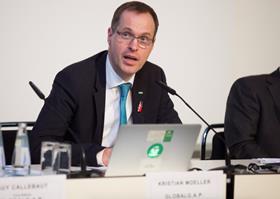
You recently reported that 2015 was a ‘record growth year’ for GlobalGAP. What are the figures behind this growth?
Kristian Moeller: I used this phrase to demonstrate that we are currently in a strong phase of our history and continue to be a reliable partner. And yet, we are looking ahead at the changes that we anticipate in the future, so that we can act accordingly without being surprised. For example, more than 15,000 new growers were added to those under certification in 2015.
What were the major developments seen by the organisation in 2015?
KM: The introduction of Version 5 of our standard, and the renewal of our technical committee structure through elections – we are the only standard owner that has such a formal representation and governance structure, as we are membership-based. We also had a record number of participants in our regional events (more than 1,600) with a record number of stops (13), and GRASP assessments have sky-rocketed to exceed 13,000 growers.
What are your priorities in 2016?
KM: The main objective is to ensure a smooth introduction of Version 5 standard, which became obligatory in July 2016, and of course Summit2016 in Amsterdam, where we will celebrate the 20-year anniversary of our partnership and 15 years of certification. The market demands traceability and sustainability and we are addressing this with increased efforts to build strong partnerships with other standards and organisations, with the aim of reducing costs for producers in order to demonstrate compliance with consumer requirements in different markets. Synergies and transparency remain the main drivers towards that objective.
Where do the major opportunities for GAP certification lie?
KM: Our 20 years of experience show us that GAP certification is increasingly important. Most retailers and an increasing number of processors consider GAP certification to be a license to market entry for suppliers and to protect buyers’ reputational risks. However, it is much more: with new hygiene rules embedded in Version 5, it’s a major opportunity to implement a milestone towards more consumer health through improved food safety resulting from the incentive to go for GAP certification.
Where are the growth markets for GlobalGAP?
KM: Europe is still a market that is growing, as we see more and more retailers introducing GlobalGAP in their national subsidiaries, which is a step towards a European strategy. But the internal growth in the USA, as well as exports to the USA due to FMSA will be visible. And last but not least, we see growing interest in Asia and Africa.
You recently said digitalisation will have a 'profound effect' on the industry - in what way, and how will you adapt?
KM: If you add up the numbers of farms around the world that will one day require proof of GAP certification, its current form might not be the only and most efficient tool to do that. We need new IT solutions to complement that process, so that audit firms can handle far more farms and it is less costly for farmers to receive certification, as less travel time by humans will be required. We are currently piloting new standards in markets for produce that is not for fresh consumption. We should wait for the results and learn from them as a global community.
Is there anything else that you would like to add?
KM: GAP certification is often seen as a given by many markets, which still require differentiation from other markets. And there lies the difficulty: growers only have a limited ability to comply with complex and overlapping criteria as a result of a wide international customer base. It is, therefore, the obligation of any responsible standard owner to seek any opportunity to collaborate with other standard owners to reduce that burden of duplication in certification and on-farm practices. We at GlobalGAP take that obligation very seriously. IT is part of our DNA, our purpose of existence. It is not always easy, but the market needs to demand more of it and value standards that demonstrate a successful track record of harmonisation.






No comments yet